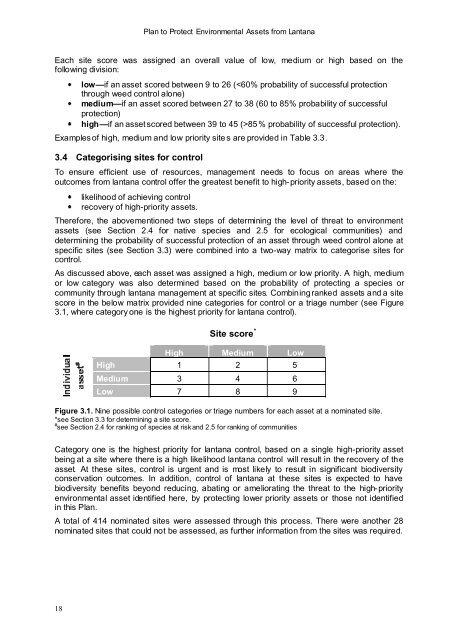Plan to Protect Environmental Assets from Lantana - Weeds Australia
Plan to Protect Environmental Assets from Lantana - Weeds Australia
Plan to Protect Environmental Assets from Lantana - Weeds Australia
Create successful ePaper yourself
Turn your PDF publications into a flip-book with our unique Google optimized e-Paper software.
<strong>Plan</strong> <strong>to</strong> <strong>Protect</strong> <strong>Environmental</strong> <strong>Assets</strong> <strong>from</strong> <strong>Lantana</strong><br />
Each site score was assigned an overall value of low, medium or high based on the<br />
following division:<br />
low—if an asset scored between 9 <strong>to</strong> 26 (85% probability of successful protection).<br />
Examplesof high, medium and low priority site s are provided in Table 3.3.<br />
3.4 Categorising sites for control<br />
To ensure efficient use of resources, management needs <strong>to</strong> focus on areas where the<br />
outcomes <strong>from</strong> lantana control offer the greatest benefit <strong>to</strong> high-priority assets, based on the:<br />
likelihood of achieving control<br />
recovery of high-priority assets.<br />
Therefore, the abovementioned two steps of determining the level of threat <strong>to</strong> environment<br />
assets (see Section 2.4 for native species and 2.5 for ecological communities) and<br />
determining the probability of successful protection of an asset through weed control alone at<br />
specific sites (see Section 3.3) were combined in<strong>to</strong> a two-way matrix <strong>to</strong> categorise sites for<br />
control.<br />
As discussed above, each asset was assigned a high, medium or low priority. A high, medium<br />
or low category was also determined based on the probability of protecting a species or<br />
community through lantana management at specific sites. Combiningranked assets and a site<br />
score in the below matrix provided nine categories for control or a triage number (see Figure<br />
3.1, where category one is the highest priority for lantana control).<br />
Site score *<br />
High Medium Low<br />
High 1 2 5<br />
Medium 3 4 6<br />
Low 7 8 9<br />
Figure 3.1. Nine possible control categories or triage numbers for each asset at a nominated site.<br />
*see Section 3.3 for determining a site score.<br />
# see Section 2.4 for ranking of species at riskand 2.5 for ranking of communities<br />
Category one is the highest priority for lantana control, based on a single high-priority asset<br />
being at a site where there is a high likelihood lantana control will result in the recovery of the<br />
asset. At these sites, control is urgent and is most likely <strong>to</strong> result in significant biodiversity<br />
conservation outcomes. In addition, control of lantana at these sites is expected <strong>to</strong> have<br />
biodiversity benefits beyond reducing, abating or ameliorating the threat <strong>to</strong> the high-priority<br />
environmental asset identified here, by protecting lower priority assets or those not identified<br />
in this <strong>Plan</strong>.<br />
A <strong>to</strong>tal of 414 nominated sites were assessed through this process. There were another 28<br />
nominated sites that could not be assessed, as further information <strong>from</strong> the sites was required.<br />
18

















